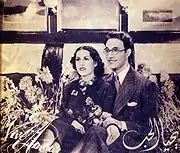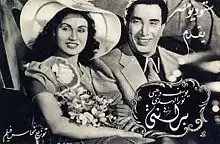Cinema of Egypt
The cinema of Egypt refers to the flourishing film industry based in Cairo which is known to be the Hollywood of the MENA region. Since 1976, the capital has held the annual Cairo International Film Festival, which has been accredited by the International Federation of Film Producers Associations.[5] There is also another festival held in Alexandria. Of the more than 4,000 short and feature-length films made in MENA region since 1908, more than three-quarters were Egyptian films. Egyptian films are typically spoken in the Arabic language, especially the Egyptian Arabic dialect.
| Egyptian Cinema | |
|---|---|
 | |
| No. of screens | 221 (2015) [1] |
| • Per capita | 0.4 per 100,000 (2010)[1] |
| Main distributors | The Trinity: (Nasr - Oscar - El Massah) Cinema Masr Sphinix Studio Masr[2] |
| Produced feature films (2005–2009)[3] | |
| Total | 42 (average) |
| Number of admissions (2015)[4] | |
| Total | 9,561,000 |
| Gross box office (2015)[4] | |
| Total | $267 million |
History
Beginnings
| This article is part of a series on |
| Life in Egypt |
|---|
 |
| Culture |
| Society |
|
| Politics |
| Economy |
|
Egypt portal |

A limited number of silent films were made in Egypt beginning in 1896; 1927's Laila was notable as the first full-length feature. Cairo's film industry became a regional force with the coming of sound. Between 1930 and 1936, various small studios produced at least 44 feature films. In 1936, Studio Misr, financed by industrialist Talaat Harb, emerged as the leading Egyptian equivalent to Hollywood's major studios, a role the company retained for three decades.[6]
Historians disagree in determining the beginning of cinema in Egypt. Some say in 1896, when the first film was watched in Egypt, while others date the beginning from 20 June 1907 with a short documentary film about the visit of Khedive Abbas Hilmi II to the Institute of Mursi Abul-Abbas in Alexandria. In 1917, the director Mohammed Karim established a production company in Alexandria. The company produced two films: Dead Flowers and Honor the Bedouin, which were shown in the city of Alexandria in early 1918.
Since then, more than 4,000 films have been produced in Egypt, three quarters of the total Arab production. Egypt is the most productive country in the Middle East in the field of film production, and the one with the most developed media system.
The Golden Age

The 1940s, 1950s and the 1960s are generally considered the golden age of Egyptian cinema. In the 1950s, Egypt's cinema industry was the world's third largest.[7] As in the West, films responded to the popular imagination, with most falling into predictable genres (happy endings being the norm), and many actors making careers out of playing strongly typed parts. In the words of one critic, "If an Egyptian film intended for popular audiences lacked any of these prerequisites, it constituted a betrayal of the unwritten contract with the spectator, the results of which would manifest themselves in the box office."[8]
In 1940,[9] the entrepreneur and translator Anis Ebeid established "Anis Ebeid Films", as the first subtitling company in Egypt and the rest of the Middle East, bringing hundreds of American and World movies to Egypt. Later he entered the movie distribution business too.[10]
Political changes in Egypt after the overthrow of King Farouk in 1952 initially had little effect on Egyptian film. The Nasser regime sought control over the industry only after turning to socialism in 1961.[11] By 1966, the Egyptian film industry had been nationalized. As with all matters in that period, diametrical opinions can be found about the cinema industry then. In the words of Ahmed Ramzi, a leading man of the era, "it went to the dogs".[12] The "heavy government hand" that accompanied nationalization of Egyptian film "stifled innovative trends and sapped its dynamism".[11] However, considering a rather modern moderate review like that given by Dubai International Film Festival, Most of the 44 Egyptian films featuring in the best 100 Arab films of all time were produced during that period. Notable titles included The Night of Counting The Years, Cairo Station and The Postman.
By the 1970s, Egyptian films struck a balance between politics and entertainment. Films such as 1972's Khalli Balak min Zouzou (Watch out for Zouzou), starring "the Cinderella of Arab cinema", Suad Husni, sought to balance politics and audience appeal. Zouzou integrated music, dance, and contemporary fashions into a story that balanced campus ferment with family melodrama.[13]
Hassan Ramzi's 1975 Egyptian film Al-Rida’ al-Abyad (The White Gown) was released in the Soviet Union in 1976, selling 61 million tickets in the country. This made it the highest-grossing foreign film of the year and the seventh highest-grossing foreign film ever in the Soviet Union.[14][15] This also made it the highest-grossing Egyptian film of all time, with its Soviet ticket sales surpassing the worldwide ticket sales of all other Egyptian films.[16]
Transitional period
The late 1970s and 1980s saw the Egyptian film industry in decline, with the rise of what came to be called "contractor movies". Actor Khaled El Sawy has described these as films "where there is no story, no acting and no production quality of any kind... basic formula movies that aimed at making a quick buck." The number of films produced also declined, from nearly 100 movies a year in the industry's prime to about a dozen in 1995. This lasted until summer 1997, when "Ismailia Rayeh Gayy" (translation: Ismailia back and forth) shocked the cinema industry, enjoying unparalleled success and large profits for the producers, introducing Mohamed Fouad (a famous singer) and Mohamed Henedi, then a rather unknown actor who later became the number one comedian star. Building on the success of that movie, several comedy films were released in the following years.
Present
Since the 1990s, Egypt's cinema has gone in separate directions. Smaller art films attract some international attention but sparse attendance at home. Popular films, often broad comedies such as What A Lie!, and the extremely profitable works of comedian Mohamed Saad, battle to hold audiences either drawn to Western films or, increasingly, wary of the perceived immorality of film.[11]
A few productions, such as 2003's Sahar el Layali (Sleepless Nights), intertwined stories of four bourgeois couples[17] and 2006's Imarat Yacoubian (The Yacoubian Building) bridge this divide through their combination of high artistic quality and popular appeal.
In 2006, the film Awkat Faragh (Leisure Time) was released. A social commentary on the decline of Egyptian youth, the film was produced on a low budget and had attendant low production values. The film, however, became a success. Its controversial subject matter, namely, the sexual undertones in today's society, was seen as confirmation that the industry was beginning to take risks.
A major challenge facing Egyptian and international scholars, students and fans of Egyptian film is the lack of resources in terms of published works, preserved and available copies of the films themselves, and development in Egypt of state and private institutions dedicated to the study and preservation of film. The Egyptian National Film Centre (ENFC), which theoretically holds copies of all films made after 1961, is according to one Egyptian film researcher, "far from being a library, houses piles of rusty cans containing positive copies."[18]
The year 2007, however, saw a considerable spike in the number of Egyptian films made. In 1997, the number of Egyptian feature-length films created was 16; 10 years later, that number had risen to 40. Box office records have also risen significantly, as Egyptian films earned around $50 million while American films, by comparison, earned $10 million.
Festivals
Since 1976, Cairo has held the annual Cairo International Film Festival, which has been accredited by the International Federation of Film Producers Associations.[5] Another festival is held in Alexandria. Recently, another film festival was established, the Gouna Film Festival, which is held annually in the beautiful Gouna city by the Red Sea in the autumn.
Notable films
Cinema of Egypt |
|---|
| List of Egyptian films |
| Pre 1920 |
| 1920s |
|
1920 1921 1922 1923 1924 1925 1926 1927 1928 1929 |
| 1930s |
|
1930 1931 1932 1933 1934 1935 1936 1937 1938 1939 |
| 1940s |
|
1940 1941 1942 1943 1944 1945 1946 1947 1948 1949 |
| 1950s |
|
1950 1951 1952 1953 1954 1955 1956 1957 1958 1959 |
| 1960s |
|
1960 1961 1962 1963 1964 1965 1966 1967 1968 1969 |
| 1970s |
|
1970 1971 1972 1973 1974 1975 1976 1977 1978 1979 |
| 1980s |
|
1980 1981 1982 1983 1984 1985 1986 1987 1988 1989 |
| 1990s |
|
1990 1991 1992 1993 1994 1995 1996 1997 1998 1999 |
| 2000s |
|
2000 2001 2002 2003 2004 2005 2006 2007 2008 2009 |
| 2010s |
|
2010 2011 2012 2013 2014 2015 2016 2017 |
| Title | Transliteration | Year | Director |
|---|---|---|---|
| My Father above the Tree [19] | Abi foq al-Shagara | 1969 | Hussein Kamal |
| The Asphalt boogymen[20] | Afarit el-asphalt | 1996 | Oussama Fawzi |
| Ali Baba and The Forty Thieves[21] | Ali Baba wa Al Arbaeen harami | 1942 | Togo Mizrahi |
| I Am Free | Ana Horra | 1959 | Salah Abu Seif |
| Date Wine[22] | Arak el-balah | 1998 | Radwan El-Kashef |
| The Land Of Fear[23] | Ard El-Khof | 1999 | Daoud Abdel Sayed |
| Al-Go'a | Al-Go'a | 1986 | Ali Badrakhan |
| The Land[24] | El Ard | 1969 | Youssef Chahine |
| The Sparrow[25] | Al Asfour | 1972 | Youssef Chahine |
| The Return of the Prodigal Son[26] | Awdat al ibn al dal | 1976 | Youssef Chahine |
| Sons of Egypt[27] | Awlad Masr | 1933 | Togo Mizrahi |
| The Days of Sadat | Ayam El-Sadat | 2001 | Mohamed Khan |
| The Soft Hands | Al Ayde Al Na'ema | 1963 | Mahmoud Zulfikar |
| The Will[28] | El Azima | 1939 | Kamal Selim |
| The Gate of Sun | Bab el shams | 2004 | Yousry Nasrallah |
| Cairo Station | Bab El-Hadid | 1958 | Youssef Chahine |
| I Love Cinema | Baheb el cima | 2004 | Oussama Fawzi |
| The Search for Sayed Marzouk | Al Bahths an Al Sayyid Marzuq | 1990 | Daoud Abdel Sayed |
| The Innocent | El Baree' | 1988 | Atef El-Tayeb |
| Barsoum Looking for a Job | Barsoum Yabhas Aen Wazifa | 1923 | Mohamed Bayoumi |
| A Beginning and an End | Bidaya wa Nihaya | 1960 | Salah Abu Seif |
| The Postman | Al Boustaguy | 1968 | Hussein Kamal |
| The Path of Mahabil | Darb al-mahabil | 1955 | Tawfik Saleh |
| The Nightingale's prayer | Doaa al-Karawan | 1959 | Henry Barakat |
| Traffic Light | Eisharit morour | 1995 | Khairy Beshara |
| In the Land of Tutankhamun | Fi bilad Tout Ankh Amoun | 1923 | Mohamed Bayoumi |
| The Paradise of the Fallen Angels | Gannat al shayateen | 1999 | Oussama Fawzi |
| The Island | El Geezera | 2007 | Sherif Arafa |
| The Flirtation of Girls | Ghazal Al Banat | 1949 | Anwar Wagdi |
| The Sin | Al Haram | 1965 | Henry Barakat |
| Chafika et Metwal | Shafika w Metwally | 1978 | Ali Badrakhan |
| Hassan and Marcus | Hassan wi Mor'os | 2008 | Ramy Emam |
| Life or Death | Haya aw Maut | 1954 | Kamal El Sheikh |
| The Choice | Al Ikhtiyar | 1970 | Youssef Chahine |
| Terrorism and Kebab | Al Irhab wal kabab | 1992 | Sherif Arafa |
| Alexandria... Why? | Iskanderija ... lih? | 1978 | Youssef Chahine |
| Karnak | Al Karnak | 1975 | Ali Badrakhan |
| The Kit Kat | El Kit Kat | 1991 | Daoud Abdel Sayed |
| The Lady's Puppet | Laabet el sitt | 1946 | Waley-ElDin Sameh |
| Leila | 1927 | Aziza Amir | |
| Angel of Mercy | Malak al-Rahma | 1946 | Youssef Wahbi |
| The City[29] | El Medina | 1999 | Yousry Nasrallah |
| The Night of Counting the Years | Al Mummia | 1975 | Shadi Abdel Salam |
| The Impossible | El Mustahil | 1966 | Hussein Kamal |
| Saladin The Victorious | El Nasser Salah El-Din | 1963 | Youssef Chahine |
| Yaaqubian building | Omaret yakobean | 2006 | Marwan Hamed |
| A Bullet in the Heart | Rossassa Fel Qalb | 1944 | Mohammed Karim |
| Return My Heart Back | Rudda Kalbi | 1958 | Ezz-El-Din Zulfikar |
| Salama is Okay | Salama fi khair | 1938 | Niazi Mostafa |
| Salamah | 1945 | Togo Mizrahi | |
| The Bus Driver | Sawaq El-Autobis | 1983 | Atef El-Tayeb |
| Some of the Fear | Shey min el khouf | 1969 | Hussein Kamal |
| Struggle of the Heroes | Sira' Al Abtal | 1962 | Tawfik Saleh |
| Black Market | Suq al-Soda, Al | 1945 | Kamel El-Telmissany |
| Adrift on the Nile | Tharthara Fawq Al Neel | 1971 | Hussein Kamal |
| The Collar and the Bracelet | El Tooq wal Eswera | 1986 | Khairy Beshara |
| Adieu Bonaparte | Weda'an Bonapart | 1985 | Youssef Chahine |
| The Two Orphans [30] | Al Yateematain | 1949 | Hassan Al Imam |
| The Sixth Day[31] | Al Yawm al-Sadis | 1986 | Youssef Chahine |
| Happy Day[32] | Yawm Saeed | 1940 | Mohammed Karim |
| Sweet Day, Bitter Day[33] | Yom mor ... Yom helw | 1988 | Khairy Beshara |
| The Wife of an Important Man | Zawgat Ragol Mohim | 1988 | Mohamed Khan |
| Zeinab[34] | 1950 | Mohammed Karim | |
| The Second Wife | El Zouga El Tania | 1967 | Salah Abu Seif |
| The White Gown | Al-Rida’ al-Abyad | 1975 | Hassan Ramzi |
| People on the Top | Ahl el qema | 1981 | Ali Badrakhan |
Notable figures
Directors
- Ahmed Badrakhan (1909–1969)
- Anwar Wagdi (1904–1955)
- Atef E-Taieb (1947–1995)
- Daoud Abdel Sayed (1946–)
- Ezzel Dine Zulficar (1919–1963)
- Hassan Al Imam (1919–1988)
- Henry Barakat (1912–1997)
- Hussein Kamal (1932–2003)
- Jehane Noujaim (1974–)
- Khairy Beshara (1947–)
- Maher Sabry (1967–)
- Mahmoud Zulfikar (1914–1970)
- Marwan Hamed (1970–)
- Mohamed Khan (1942–2016)
- Mohammed Karim (1896–1972)
- Salah Abu Seif (1915–1996)
- Shady Abdel Salam (1930–1986)
- Sherif Arafa (1960–)
- Tamer El Said (1972–)
- Yousry Nasrallah (1952–)
- Youssef Chahine (1926–2008)
- Youssef Wahbi (1898–1982)
Cinematographers
- Tarek El-Telmissany (1950–)
Actors
- Abdelhalim Hafez (El Andaleeb) (1929–1977)
- Adel Emam (El Zaeem) (1940–)
- Ahmed El Sakka (1973–)
- Ahmed Helmy (1969–)
- Ahmed Mazhar (1917–2002)
- Ahmad Zaki (1949–2005)
- Amina Rizk (1910–2003)
- Anwar Wagdi (1904–1955)
- Elham Shahin (1961–)
- Emad Hamdy (1909–1984)
- Ezzel Dine Zulficar (1919–1963)
- Farid al-Atrash (1915–1974)
- Farid Shawky (1920–1998)
- Farouk al-Fishawy (1952–2019)
- Faten Hamama (1931–2015)
- Fuad Al Mohandes (El Ostaz) (1924–2006)
- Hend Rostom (1929–2011)
- Hussein Fahmy (1940–)
- Ismail Yasin (1912–1972)
- Khaled Abol Naga (1966–)
- Laila Elwi (1962–)
- Layla Murad (1918–1995)
- Lebleba (1945–)
- Madiha Yousri (1921–2018)
- Magda (1931–2020)
- Mahmoud Abdel Aziz (1946–2016)
- Mahmoud Yacine (1941–2020)
- Mariam Fakhr Eddine (1933–2014)
- Mary Queeny (1913–2003)
- Mervat Amin (1946–)
- Mohamed Abdel Wahab (1902–1991)
- Mohamed Henedi (1965–)
- Mona Zaki (1976–)
- Mounira El Mahdeya (1885–1965)
- Nabila Ebeid (1945–)
- Nadia Al-Gindi (1946–)
- Nadia Lutfi (1937–2020)
- Nagat El-Sagheera (1938–)
- Naglaa Fathi (1951–)
- Naguib Al Rihani (1889–1949)
- Naima Akef (1932–1966)
- Nelly Mazloum (1929–2003)
- Nour El-Sherif (1946–2015)
- Omar Sharif (1932–2015)
- Poussi (1953–)
- Rushdy Abaza (1926–1980)
- Sabah (singer) (1921–2014)
- Safia El Emari (1949–)
- Samia Gamal (1924–1994)
- Samir Ghanem (1937–)
- Sanaa Gamil (1932–2002)
- Shadia (1929–2017)
- Shukry Sarhan (1925–1997)
- Shwikar (1939–2020)
- Soad Hosni (El Cindrella) (1943–2001)
- Soher Al Bably (1937–)
- Tahiya Carioca (1920–1999)
- Youssef Wahbi (1898–1982)
- Yousra (1955–)
- Zaki Rostom (1903–1972)
Film critics
- Samir Farid (1943–2017)
Music Composers
- Ammar El Sherei (1948–2012)
- Omar Khairat (1948–present)
- Ahmed Elgamal (1960's-Early 2000's)
See also
- Media of Egypt
- Cinema of the world
- Culture of Egypt
- List of Egyptian films
References
- "Table 8: Cinema Infrastructure - Capacity". UNESCO Institute for Statistics. Retrieved 5 November 2013.
- "Table 6: Share of Top 3 distributors (Excel)". UNESCO Institute for Statistics. Retrieved 5 November 2013.
- "Average national film production". UNESCO Institute for Statistics. Retrieved 5 November 2013.
- "Table 11: Exhibition - Admissions & Gross Box Office (GBO)". UNESCO Institute for Statistics. Retrieved 4 December 2017.
- Cairo Film Festival information Archived 2011-12-08 at the Wayback Machine.
- Darwish, Mustafa, Dream Makers on the Nile: A Portrait of Egyptian Cinema, The American University in Cairo Press, Cairo, 1998, Pp. 12–13.
- A.V. "The rise and fall of Egyptian Arabic". The Economist. Retrieved 1 February 2018.
- Farid, Samir, "Lights, camera...retrospection" Archived 2013-05-11 at the Wayback Machine, Al-Ahram Weekly, December 30, 1999
- "Archived copy". Archived from the original on 2013-09-24. Retrieved 2013-09-24.CS1 maint: archived copy as title (link)
- "Archived copy". Archived from the original on 2013-09-28. Retrieved 2013-09-24.CS1 maint: archived copy as title (link)
- Farid, Samir, "An Egyptian Story" Archived 2013-05-14 at the Wayback Machine, Al-Ahram Weekly, November 23–29, 2006
- Khairy, Khaireya, "Ahmed Ramzi: rendezvous at the snooker club" Archived 2007-04-12 at the Wayback Machine, Al-Ahram Weekly, June 22, 2000
- Anis, Mouna, "Before the public gaze" Archived 2003-05-10 at the Wayback Machine, Al-Ahram Weekly, June 28, 2001
- Sergey Kudryavtsev (4 July 2006). "Зарубежные фильмы в советском кинопрокате". LiveJournal (in Russian).
- "«Белое платье» (Al-Reda' Al-Abiad, 1973)". KinoPoisk (in Russian). Retrieved 25 May 2020.
- "Советский кинопрокат – Империя наносит ответный удар". Krasnoyeznamya.ru (in Russian). Retrieved 25 May 2020.
- "Sahar el Layali", The New York Times, 2004
- El-Assyouti, Mohamed, "Forgotten memories" Archived 2013-05-13 at the Wayback Machine,Al-Ahram Weekly, September 2, 1999
- "Abi foq al-Shagara". 17 February 1969 – via www.imdb.com.
- "Afarit el-asphalt". 11 August 1996 – via www.imdb.com.
- "Ali Baba and the Forty Thieves" – via www.imdb.com.
- "Date Wine". 1 September 1999 – via www.imdb.com.
- "Land of Fear". 14 March 2007 – via www.imdb.com.
- "The Land". 4 August 2012 – via www.imdb.com.
- "Al-asfour". 28 October 2007 – via www.imdb.com.
- "Awdat al ibn al dal". 5 August 2012 – via www.imdb.com.
- "Sons of Egypt" – via www.imdb.com.
- "The Will". 6 November 1939 – via www.imdb.com.
- "El Medina". 5 July 2000 – via www.imdb.com.
- "The Two Orphans" – via www.imdb.com.
- "Al-yawm al-Sadis". 3 December 1986 – via www.imdb.com.
- "A Happy Day" – via www.imdb.com.
- "Yom mor... yom helw" – via www.imdb.com.
- "Zeinab". 18 May 2018 – via www.imdb.com.
Further reading
- Viola Shafik, Popular Egyptian Cinema: Gender, Class, and Nation, American University in Cairo Press, 2007, ISBN 978-977-416-053-0
- Walter Armbrust, "Political Film in Egypt" in: Josef Gugler (ed.) Film in the Middle East and North Africa: Creative Dissidence, University of Texas Press and American University in Cairo Press, 2011, ISBN 978-0-292-72327-6, ISBN 978-9-774-16424-8, pp 228–251
External links
- African Media Program Comprehensive database of African media
- El-Cinema.com (an IMDb inspired Egyptian/Arabic movie database)